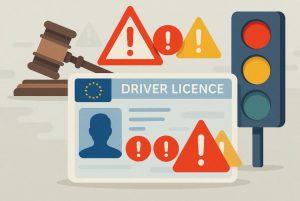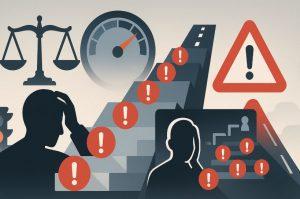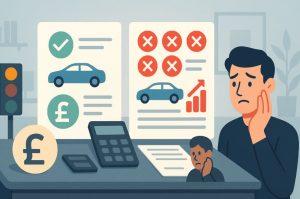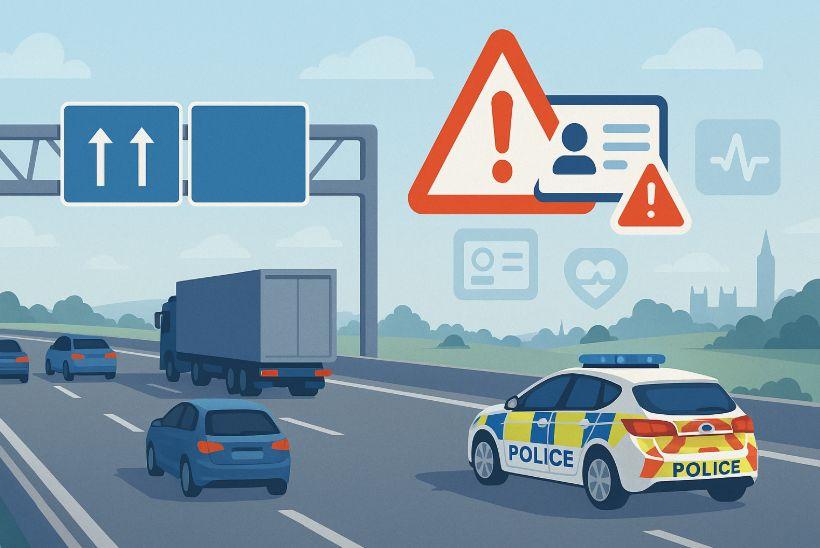In the United Kingdom, the legal framework surrounding driver responsibility is underpinned by the penalty point system. Designed to improve road safety, this system allows the DVLA to monitor and penalise motorists who commit traffic offences.
Understanding how many points can lead to a licence suspension is essential for every driver especially those navigating the roads in busy cities like London. This comprehensive guide outlines the thresholds, rules, consequences, and options available for drivers dealing with penalty points and potential licence disqualification.
What Are Penalty Points and How Do They Affect Your UK Driving Licence?

Penalty points as a legal measure
Penalty points, also referred to as endorsements, are issued when a driver is found guilty of specific motoring offences. Offences can vary from less severe infractions like speeding to more serious violations such as reckless driving or operating a vehicle while impaired. Points are added to your driving licence and monitored by the DVLA.
Electronic recording of points
Once issued, these points are electronically stored and become part of your official driving record. This record can be accessed by insurers, employers, and authorities, which means that the impact of points extends beyond legal consequences. it can affect financial costs and employment opportunities.
Influence on your driving privileges
The accumulation of too many points within a short period may lead to licence suspension, higher insurance costs, mandatory retesting, or even the need to retake both theory and practical driving tests. The consequences can be immediate and long-lasting.
How Many Penalty Points Can Lead to a Driving Licence Suspension in the UK?
The two-year probation rule for new drivers
Under UK law, drivers who have passed their test within the last two years face stricter rules. If a new driver accumulates six or more points within this probationary period, their licence will be revoked.
As a result, they lose their full licence and are required to reapply for a provisional one. To regain their full driving privileges, they must pass both the theory and practical driving tests again.
The 12-point threshold for experienced drivers
For drivers who passed their test more than two years ago, the rules differ. Reaching a total of 12 penalty points within a three-year period can lead to a driving ban being imposed by the court.This is referred to as the “totting-up” system and is handled by the courts, who determine the ban duration based on the driver’s offence history.
Whar are The Difference Between New and Experienced Drivers?
Licence vulnerability in early years
New drivers are considered higher risk due to limited road experience. As such, the law is deliberately more stringent, encouraging responsible driving from the outset. A single serious offence or two minor infractions may be all it takes for a new driver to lose their licence.
Greater allowance for seasoned drivers
Experienced drivers are allowed a broader margin before facing suspension. They can accumulate up to 11 points without immediate disqualification, although each additional offence increases the risk of reaching the 12-point limit.
How the Totting-Up System Functions in the UK?

Accumulating offences over time
The totting-up system tracks the accumulation of penalty points over a rolling three-year period. When a driver’s total reaches 12 or more, the DVLA notifies the courts, and a potential driving disqualification is initiated.
Consideration of hardship circumstances
In certain cases, drivers may avoid a ban if they can demonstrate exceptional hardship. This includes scenarios such as job loss, inability to care for dependents, or severe financial implications. However, the burden of proof lies with the driver, and the court must be convinced that the hardship is significant and unavoidable.
What Are the Disqualification Periods Based on Driving History?
First-time disqualification guidelines
A first-time offender who reaches 12 points within three years typically faces a six-month driving ban. This type of ban falls under the typical guidelines set by the totting-up system for repeat offences.
Repeat offences and escalating bans
Repeat offenders face harsher penalties. If a second disqualification occurs within three years of the first, the ban is extended to 12 months. A third offence within the same time frame results in a two-year disqualification. These progressive measures are intended to deter repeated poor driving behaviour.
How Long Do Penalty Points Stay on a Driving Record in the UK?
Variation based on offence severity
The length of time that points stay on your driving record depends on the seriousness of the offence. Minor offences such as speeding typically stay on your licence for four years. More severe violations, including drink or drug driving, can remain for up to eleven years.
Impact on driving eligibility and visibility
Although points stay on your licence for a number of years, only those received in the last three years count towards disqualification through the totting-up process.
Nonetheless, all recorded points can influence insurance premiums and employer decisions until they expire.
How to Check Your Penalty Points Online?

Accessing your driving record
Drivers in the UK can check their current licence status through the DVLA’s free online service. To log in, you need your driving licence number, National Insurance number, and postcode. The portal displays your total penalty points, endorsement codes, and disqualification status if applicable.
Importance of regular checks
It’s advisable to periodically review your record to ensure accuracy and to stay informed about your standing as a driver. Mistakes, while rare, can occur and may impact your legal and financial obligations.
What Are the Requirements After a Driving Ban in the UK?
Reapplying for your driving licence
If you are disqualified for 56 days or more, you must reapply for a driving licence before returning to the road. Depending on the offence, this could be a straightforward process or one that requires additional steps.
Retesting obligations
In many cases, especially those involving dangerous driving or drink-related offences, the court may require you to pass an extended driving test. This assessment is more rigorous than the standard driving test and is designed to ensure the driver can operate safely before being allowed back on the road.
Are There Any Alternatives to Receiving Penalty Points in the UK?
Speed awareness courses
For some offences usually minor speeding incidents drivers may be offered a speed awareness course in place of points. These courses last around four hours and are either conducted in person or online. Completion means no points are added to your record, though the offence remains logged with the police.
Police discretion and eligibility
Eligibility for such a course depends on factors such as the severity of the offence and whether a course has been taken in the past three years. These programmes are not guaranteed and are at the discretion of the local police authority.
How Do Penalty Points Affect Car Insurance in the UK?

Increased risk and premium costs
Penalty points signal higher risk to insurance providers. As a result, even a minor endorsement can cause premiums to rise. The more points on your record, the more you can expect to pay in insurance costs.
Legal obligation to disclose
Drivers are legally required to inform their insurer of any points received. Failing to disclose this information could lead to policy invalidation, refused claims, and even accusations of insurance fraud.
What Happens After a Driving Ban Ends?
Steps to regain your driving rights
Once your disqualification period ends, you must follow the legal process to resume driving. This usually begins with reapplying for your licence. In some cases, a retest may be required before reinstatement is granted.
Long-term effects on your record
Even after your licence is reinstated, your driving history remains visible for years. Insurers and potential employers may still view your record as high-risk, especially if your disqualification was for a serious or repeated offence.
Penalty Points and Licence Suspension
| Driver Category | Points Limit | Outcome | Additional Requirements |
| New Drivers | 6 points | Licence revoked | Reapply for provisional, retake tests |
| Experienced Drivers | 12 points | Disqualification via totting-up | Possible retest, based on court decision |
| First-time Disqualified | 12 points | 6-month ban | None (unless ordered) |
| Second-time Offenders | 12 points | 12-month ban | As above |
| Third-time Offenders | 12 points | 2-year ban | Likely retest requirement |
Conclusion
Understanding how driving penalty points work in the UK is essential for maintaining your licence and avoiding serious consequences such as disqualification. Whether you’re a new driver facing stricter limits or an experienced motorist nearing the totting-up threshold, staying informed can help you make responsible decisions.
Regularly checking your licence status, complying with road laws, and addressing offences promptly can protect not just your legal right to drive but also your financial and professional future.
FAQs
What is the totting-up ban and how does it apply?
The totting-up ban occurs when a driver accumulates 12 or more points in three years. This results in a court-ordered disqualification, typically lasting six months for first-time offenders.
Can you reduce penalty points on your licence?
There is no legal method to remove active points early. However, drivers can avoid new points by attending speed awareness courses or contesting charges if they believe they were wrongly accused.
Will I lose my job if I get a driving ban in the UK?
This depends on your occupation. Those employed as delivery drivers, taxi drivers, or anyone reliant on a vehicle for work are at higher risk of job loss following a ban.
Can I drive while waiting for a court summons?
Yes, unless your licence has already been revoked or suspended, you may continue driving until the court has officially issued a disqualification.
Do penalty points reset after a driving ban?
No. Points remain on your licence for their full duration, even if you serve a disqualification. They continue to affect your record and may influence future legal decisions.
Can I drive abroad with UK penalty points?
In most cases, UK penalty points don’t apply abroad. However, serious offences can affect international car hire and travel eligibility, particularly in EU countries.
How do I reapply for a licence after a driving disqualification?
You’ll need to complete a D1 form and submit it to the DVLA. Depending on your case, you may also have to pass a theory and/or extended driving test before receiving your new licence.









Leave feedback about this